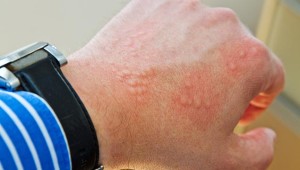Contact dermatitis is a common skin disorder. All age groups are affected, with a slight female preponderance. CD accounts for approximately 85-95% of all occupational skin disease in industrialized countries. A fundamental characteristic of CD is its relationship to environmental exposures which can be determined by the site and shape of the skin lesions as well as a thorough history.
There are two types of contact dermatitis:
• Allergic contact dermatitis: This occurs when skin, becomes sensitive to a certain substance (allergen), and comes in contact with that substance again. This is a delayed skin reaction that typically develops 12 to 72 hours after exposure.
• Irritant contact dermatitis: This occurs when the skin is repeatedly exposed to a mild irritant (such as detergent or solvents) over a long period of time. If skin is exposed to a strong irritant (acid, alkali, solvent, strong soap, or detergent), skin damage can be immediate.
CD may be suspected based on the clinical appearance and distribution of the lesions, lack of associated systemic symptoms and the absence of other plausible etiologies. Histologically, CD is characterized by intercellular edema of the epidermis (spongiosis) and varying degrees of epidermal stratum basale and stratum spinosum thickening (acanthosis). Superficial perivascular, lymphohistiocytic infiltrates are also present. It is difficult to distinguish an ACD from an ICD based on clinical and histological features. Differentiating these two conditions, however, is important especially in an occupational dermatitis.
Common allergens causing allergic contact dermatitis include nickel, chromates, rubber accelerators (thiurams, carbamates, mercaptobenzothiazole) fragrances, preservatives, paraphenylenediamine, cocoamidopropyl betaine, medications (benzocaine, neomycin, corticosteroids).
Diagnostic studies for allergic contact dermatitis include the following:
• Patch testing: To identify external chemicals to which the person is allergic.
• Repeat open application test (ROAT): To determine whether a reaction is significant in individuals who develop weak or 1+ positive reactions to a chemical.
• Dimethylgloxime test: To determine whether a metallic object contains enough nickel to provoke allergic dermatitis.
• Skin biopsy: May help to exclude other disorders, particularly tinea, psoriasis, and cutaneous lymphoma.
Treatment of contact dermatitis
Avoidance of contact with the allergen is the key to successful treatment in ACD, medical therapies like topical corticosteroids, phototherapy, oral retinoids and immunosuppressants can be used as adjunct measures. Other treatments including cyclosporine, azathioprine and psoralen plus ultraviolet A have been used for steroid-resistant ACD such as chronic hand dermatitis. However, the patient must be informed of the risks and benefits of these treatments.

